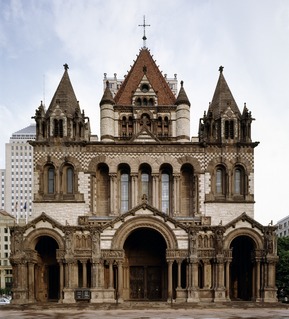
Richardsonian Romanesque is a style of Romanesque Revival architecture named after the architect Henry Hobson Richardson (1838–1886). The revival style incorporates 11th and 12th century southern French, Spanish, and Italian Romanesque characteristics. Richardson first used elements of the style in his Richardson Olmsted Complex in Buffalo, New York, designed in 1870. Multiple architects followed in this style in the late 1800s; Richardsonian Romanesque later influenced modern styles of architecture as well.

St. Luke's United Methodist Church, also known as St. Luke's Methodist and as St. Luke's United Methodist, is an historic Richardsonian Romanesque-style church located at 1199 Main Street in Dubuque, Iowa. It was individually listed on the National Register of Historic Places in 1998, and as a contributing property in the Upper Main Street Historic District in 2005. It is part of the Iowa Conference of the United Methodist Church.

The Cathedral Church of All Saints is the bishop's church of the Episcopal Diocese of Milwaukee, in Milwaukee, Wisconsin, USA. The current parish is a descendant of a small mission by the Right Reverend Jackson Kemper. It is located in Milwaukee's downtown Yankee Hill neighborhood.

St. Michael's Church is a historic Episcopal church at 225 West 99th Street and Amsterdam Avenue on Manhattan's Upper West Side in New York City. The parish was founded on the present site in January 1807, at that time in the rural Bloomingdale District. The present limestone Romanesque building, the third on the site, was built in 1890–91 to designs by Robert W. Gibson and added to the National Register of Historic Places in 1996.

Central Presbyterian Church is a church in downtown Saint Paul, Minnesota, United States. The congregation was founded in 1852 and built its first building in 1854, which was later enlarged during the 1870s. The rapidly growing congregation outgrew the building, so they built a new church building in 1889. The building, an example of Richardsonian Romanesque architecture, is listed on the National Register of Historic Places.

Trinity Episcopal Church is a historic Episcopal church located in Oshkosh, Wisconsin. The only Episcopal church in Oshkosh, Trinity is in the Diocese of Fond du Lac. The congregation first met in 1850, organizing as Trinity Episcopal Church in 1854. The current church building, which was constructed in 1887, is an example of Richardsonian Romanesque architecture. It was added to the National Register of Historic Places in 1974.
The Ecumenical Theological Seminary is a Christian theological institution in Detroit, Michigan. Founded in 1980 as the Ecumenical Theological Center, the seminary offers graduate degrees and certificates in religious studies. It is housed in a building built in 1889 to house the First Presbyterian Church; the seminary began leasing the building in 1992 and was donated the building, lands, and endowment in 2002.

The Cass Community United Methodist Church is located at 3901 Cass Avenue in Midtown Detroit, Michigan. It was built in 1883 as the Cass Avenue Methodist Episcopal Church, listed on the National Register of Historic Places in 1982, and designated a Michigan State Historic Site in 1985.

The Calvinistic Congregational Church is an historic church building located at 820 Main Street in Fitchburg, Massachusetts. In 1967, the congregation joined with the First United Methodist Church of Fitchburg to form a cooperative ministry called Faith United Parish. Built in 1896. the church was designed by architect Henry M. Francis, and is one of the city's finest examples of Richardsonian Romanesque architecture. It was added to the National Register of Historic Places in 1979. Since 2013 the building has been owned by the Casa De Gracia y Restauración.

Willoughby James Edbrooke (1843–1896) was an American architect and a bureaucrat who remained faithful to a Richardsonian Romanesque style into the era of Beaux-Arts architecture in the United States, supported by commissions from conservative federal and state governments that were spurred by his stint in 1891-92 as Supervising Architect of the U.S. Treasury Department.

St. Paul's Church is a historic Episcopal church in Lynchburg, Virginia, United States.

Edward Townsend Mix was an American architect of the Gilded Age who designed many buildings in the Midwestern United States. His career was centered in Milwaukee, Wisconsin, and many of his designs made use of the region's distinctive Cream City brick.

St. John's Episcopal Church is a parish church in the Episcopal Diocese of Iowa. It is located in Keokuk, Iowa, United States. It was listed, together with the parish hall, on the National Register of Historic Places in 1989.
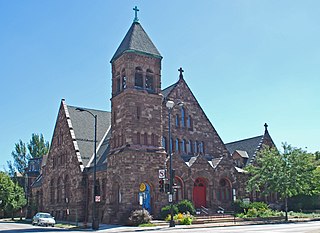
Church of the Epiphany is a historic Episcopal church located at 201 S. Ashland Avenue in Chicago, Illinois. The church was built in 1885 to replace its congregation's original church, which had grown too small for its increasing membership. Architect Francis M. Whitehouse of Chicago firm Burling and Whitehouse designed the church in the Richardsonian Romanesque style. The church has a sandstone exterior made up of irregularly coursed and roughly faced blocks; the stone was imported from Lake Superior. The building's entrances and windows are framed by heavy arches which are supported by short columns with floral decorations. A bell tower, completed in 1887, rises above the front corner of the church; the tower features patterned sections of smooth and rough stone and arched openings at the top.

St. Paul's Episcopal Church is a historic parish of the Episcopal Church in Watertown, Wisconsin,. Its buildings display different phases of Gothic Revival architecture, and in 1979 the complex was added to the National Register of Historic Places for its architectural significance.

St. Patrick's Roman Catholic Church is a historic Catholic church near Capitol Square in downtown Madison, Wisconsin. It was built to serve the former parish of St. Patrick, which was merged with the nearby parishes of St. Raphael and Holy Redeemer to form the new Cathedral Parish of St. Raphael after the old Saint Raphael's Cathedral was destroyed by arson in 2005.
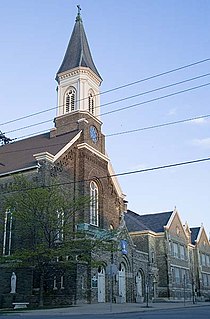
Saints Peter and Paul Roman Catholic Church Complex is located in Milwaukee, Wisconsin. The complex was added to the National Register of Historic Places in 1991 for its architectural significance.

St. Matthew's Episcopal Church is located in Kenosha, Wisconsin. It was added to the National Register of Historic Places for its architectural and religious significance in 1979. The church is a parish of the Episcopal Diocese of Milwaukee.
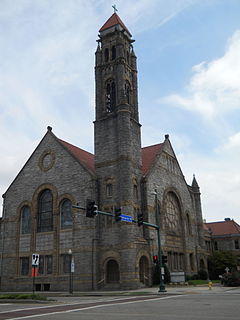
Epworth United Methodist Church, originally Epworth Methodist Episcopal Church, is a historic Methodist church located at Norfolk, Virginia. It was designed by two noted Virginia architects James Edwin Ruthven Carpenter, Jr. (1867-1932) and John Kevan Peebles (1876-1934), and built between 1894 and 1896. It is a rusticated granite with yellow sandstone trim church building in the Richardsonian Romanesque style. The original building is divided into three sections: the cruciform sanctuary, the social hall and classrooms, and the pastor's study. The building features 22 beautiful stained glass windows, most notably the Ascension flanked by two Tiffany windows. It has a bell tower topped by a pyramidal red tile roof. The church was remodeled to its present appearance in 1921.
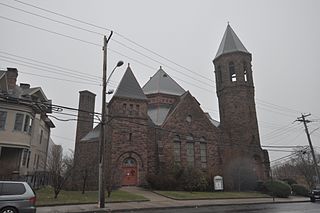
The First Baptist Church is a historic church at 126 Washington Avenue in Bridgeport, Connecticut. Built in 1893, it is a distinctive local example of Richardsonian Romanesque architecture, designed by local architect Joseph W. Northrop for a congregation founded in 1837. It was listed on the National Register of Historic Places in 1990.























